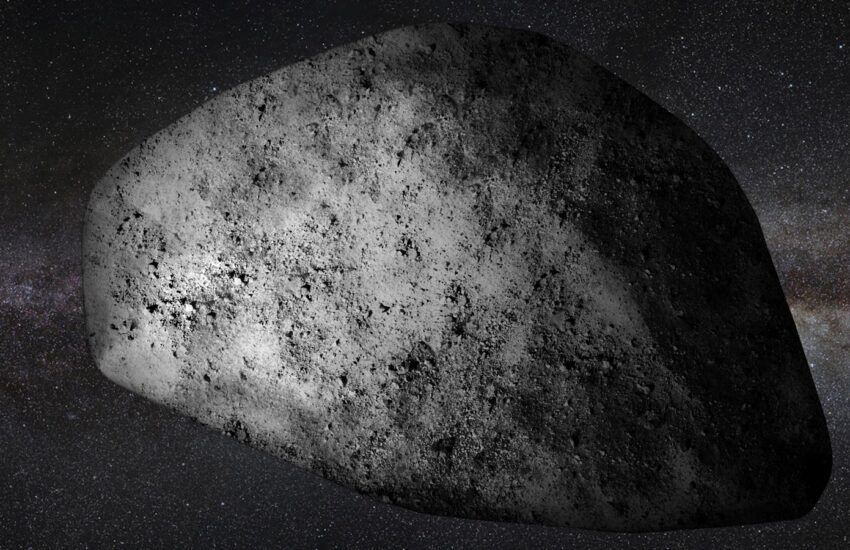Artist’s impression of the asteroid (99942) Apophis.
Updated, June 21, 2024: A reference to the Chicxulub crater, caused by a seven-miles wide asteroid that may have killed the dinosaurs, was removed from this article. Any crater left by Apophis would be much smaller.
Friday the 13th may be considered an unlucky day, but at 5:45 EDT (11:45 CEST) on Friday, April 13, 2029, it will prove the exact opposite when a massive asteroid passes safely past Earth.
Everyone will be watching. Asteroid Apophis is, at about 1,230 feet (375 meters) across, larger than 90% of space rocks.
It will pass just 19,635 miles (31,600 kilometers) from Earth’s surface, the closest approach of an asteroid of this size that humankind has ever experienced. It will pass between Earth’s geostationary satellites and the Atlantic Ocean, just a tenth of the distance between Earth and the moon.
Apophis will be visible to the naked eye. As it crosses the Atlantic, a few billion people in Europe, Africa and Asia can see it for a few hours in the night sky if skies are clear.
Discovered exactly 20 years ago this week, here’s everything you need to know about asteroid Apophis:
‘Demon Of Chaos’
Asteroid 99942 Apophis was discovered on June 19, 2004, by astronomers at Kitt Peak National Observatory, who revealed that this stony, S-type asteroid orbits the sun every 324 days and comes close to Earth every decade or so. It hit the headlines after a paper was published that calculated that it could strike Earth in 2029, 2036 or 2068. It was, therefore, named after Apophis, the Egyptian demon of chaos and destruction.
Even though there was only a 2.7% chance of a direct hit by Apophis, the devastation caused by it striking Earth led astronomers to try to understand its orbit in more detail. In 2021, radar observations by NASA’s Goldstone Deep Space Communications Complex, California and the Green Bank Observatory, West Virginia, in March 2021 refined its orbit. It was announced that Apophis would not strike Earth in 2029, 2036, or 2068.
On Friday, 13 April 2029, asteroid Apophis will make a close approach of Earth. Earth’s gravity will … [+]
Future Threat?
However, an asteroid’s orbit can only be calculated so far into the future. Although the following time it comes close to Earth, in 2044, it will be at a greater distance, astronomers can only rule out an impact for the next 100 years.
The calculations are difficult because a close flyby—such as the one in 2029—will alter Apophis’ orbit so that it could strike Earth in a future orbit. However, astronomers have reduced the uncertainty in Apophis’ orbit from hundreds to just a few miles.
The close pass in 2029 of Apophis is a rare opportunity to visit, so NASA already has a spacecraft in hot pursuit. This close pass is seen as the perfect opportunity to learn more about planetary defense and how an asteroid reacts to passing so close to a body with such enormous gravity. It’s thought that Apophis will be squeezed so much that asteroid quakes and landslides could result.
These images represent radar observations of asteroid 99942 Apophis on March 8, 9, and 10, 2021, as … [+]
Mission To Apophis
Watching closely will be NASA’s OSIRIS-Apophis Explorer (OSIRIS-APEX) spacecraft. It’s the identical spacecraft that 2020 visited Asteroid Bennu. Then called OSIRIS-REx, NASA’s first asteroid sample-return mission, it returned a package of samples to Utah in September 2023 before re-directing towards Apophis in a mission extension costing NASA $200 million. OSIRIS-APEX will orbit Apophis for 18 months as it passes Earth in 2029.
The European Space Agency is also considering a mission to Apophis, the Rapid Apophis Mission for SEcurity and Safety (RAMSES) mission, to launch in 2027.
For now, what scientists learn from sending spacecraft to study Apophis in 2029 will be about how a relic of the early solar system reacts to gravity. The findings could be crucial for future Earthlings in hundreds of years when the massive asteroid poses a bigger threat.
Wishing you clear skies and wide eyes.
Pick up my books Stargazing in 2024, A Stargazing Program For Beginners and When Is The Next Eclipse?

